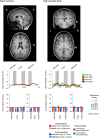Where one hand meets the other: limb-specific and action-dependent movement plans decoded from preparatory signals in single human frontoparietal brain areas
- PMID: 23365237
- PMCID: PMC6619126
- DOI: 10.1523/JNEUROSCI.0541-12.2013
Where one hand meets the other: limb-specific and action-dependent movement plans decoded from preparatory signals in single human frontoparietal brain areas
Abstract
Planning object-directed hand actions requires successful integration of the movement goal with the acting limb. Exactly where and how this sensorimotor integration occurs in the brain has been studied extensively with neurophysiological recordings in nonhuman primates, yet to date, because of limitations of non-invasive methodologies, the ability to examine the same types of planning-related signals in humans has been challenging. Here we show, using a multivoxel pattern analysis of functional MRI (fMRI) data, that the preparatory activity patterns in several frontoparietal brain regions can be used to predict both the limb used and hand action performed in an upcoming movement. Participants performed an event-related delayed movement task whereby they planned and executed grasp or reach actions with either their left or right hand toward a single target object. We found that, although the majority of frontoparietal areas represented hand actions (grasping vs reaching) for the contralateral limb, several areas additionally coded hand actions for the ipsilateral limb. Notable among these were subregions within the posterior parietal cortex (PPC), dorsal premotor cortex (PMd), ventral premotor cortex, dorsolateral prefrontal cortex, presupplementary motor area, and motor cortex, a region more traditionally implicated in contralateral movement generation. Additional analyses suggest that hand actions are represented independently of the intended limb in PPC and PMd. In addition to providing a unique mapping of limb-specific and action-dependent intention-related signals across the human cortical motor system, these findings uncover a much stronger representation of the ipsilateral limb than expected from previous fMRI findings.
Figures









References
-
- Aizawa H, Mushiake H, Inase M, Tanji J. An output zone of the monkey primary motor cortex specialized for bilateral hand movement. Exp Brain Res. 1990;82:219–221. - PubMed
-
- Andersen RA, Buneo CA. Intentional maps in posterior parietal cortex. Annu Rev Neurosci. 2002;25:189–220. - PubMed
-
- Andersen RA, Cui H. Intention, action planning, and decision making in parietal-frontal circuits. Neuron. 2009;63:568–583. - PubMed
-
- Barash S, Bracewell RM, Fogassi L, Gnadt JW, Andersen RA. Saccade-related activity in the lateral intraparietal area. I. Temporal properties; comparison with area 7a. J Neurophysiol. 1991;66:1095–1108. - PubMed
-
- Basso MA, Wurtz RH. Modulation of neuronal activity by target uncertainty. Nature. 1997;389:66–69. - PubMed
Publication types
MeSH terms
Grants and funding
LinkOut - more resources
Full Text Sources
Other Literature Sources
